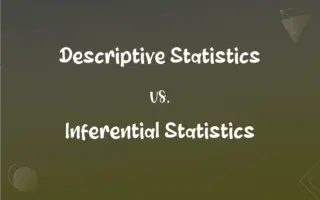Mutation vs. Variation: What's the Difference?
Edited by Janet White || By Harlon Moss || Updated on October 28, 2023
A mutation is a change in an organism's DNA sequence, while a variation refers to the differences between individuals within a population due to genetic and environmental factors.

Key Differences
At its core, a mutation pertains to a change in the DNA sequence of an organism. Such changes can arise from various factors, including exposure to radiation or chemicals. Conversely, variation is the result of the combined effects of multiple genes and environmental factors. This explains why siblings, excluding identical twins, exhibit differences despite sharing the same parents.
Mutation can be both beneficial and detrimental. A beneficial mutation might confer an evolutionary advantage, helping the organism to survive and reproduce. However, a harmful mutation could lead to diseases or disorders. Variation, meanwhile, is a natural and essential part of evolution. It ensures that populations have the genetic diversity required to adapt to changing environments.
The source of a mutation is primarily the DNA. Mutations can occur in genes (resulting in altered protein function) or non-coding regions of DNA. Variation, on the other hand, originates from the combined genetic makeup of two parent organisms and is further influenced by environmental factors throughout an individual's life.
Mutations are often spontaneous and unpredictable. They can happen at any point in an organism's life and can be passed on to offspring if they occur in reproductive cells. Variation, in contrast, is predictable to an extent. While two individuals will differ, they'll also share similarities with their parents and siblings, rooted in shared genetics.
Finally, while mutation is a fundamental source of genetic variation, not all variations stem from mutations. Some variations arise due to genetic recombination during sexual reproduction, where genes shuffle between the two parent organisms. Thus, while all mutations contribute to variation, not all variations are the result of mutations.
ADVERTISEMENT
Comparison Chart
Nature
Change in DNA sequence
Differences within a population
Cause
External agents, errors in DNA replication
Combination of genetics and environmental factors
Outcome
Can be neutral, beneficial, or harmful
Leads to diversity
Predictability
Often spontaneous and unpredictable
Somewhat predictable based on parent genetics
Relation to Evolution
Source of genetic diversity but doesn't guarantee evolution
Essential for evolution as it provides a pool of traits to select from
ADVERTISEMENT
Mutation and Variation Definitions
Mutation
An alteration that can result in a different genetic trait.
A mutation in the gene caused the plant to produce blue flowers.
Variation
A manifestation of genetic diversity.
The variation among the fruit sizes was remarkable in the orchard.
Mutation
A change in the DNA sequence of an organism.
Exposure to certain chemicals can induce mutations in DNA.
Variation
A difference or deviation found among members of the same species.
The variation in fur color among rabbits is due to both genetics and environment.
Mutation
A permanent transformation that can be inherited.
The mutation was passed down to the next generation of butterflies.
Variation
The range of differences present within a population.
Genetic tests showcased the wide variation in the sampled group.
Mutation
A deviation from the standard genetic code.
The rare mutation granted resistance against the disease.
Variation
An observable or measurable difference between individuals.
Studying variation helps scientists understand the adaptability of a species.
Mutation
A genomic phenomenon that can lead to variations within a species.
Scientists studied the mutation to understand its evolutionary implications.
Variation
A divergence arising from genetic and external factors.
Skin color variation in humans is influenced by geographical location and ancestry.
Mutation
The act or process of being altered or changed.
Variation
The act, fact, or process of varying.
FAQs
What is a mutation?
A mutation is a change in an organism's DNA sequence.
What contributes more to variation, genetics, or environment?
Both play significant roles, but the contribution varies depending on the trait in question.
Can mutations be beneficial?
Yes, some mutations can confer evolutionary advantages to organisms.
Is variation always visible?
No, variation can be both visible (like height) or invisible (like blood type).
Why is studying variation vital in evolution?
Studying variation helps understand how species adapt, change, and evolve over time.
How does variation arise?
Variation arises from the combination of genetics and environmental influences.
Why is variation essential for a population's survival?
Variation ensures genetic diversity, enabling populations to adapt to changing environments.
How do mutations relate to genetic disorders?
Harmful mutations can lead to genetic disorders if they impact genes regulating vital functions.
Does variation only pertain to physical traits?
No, variation can relate to any trait, be it physical, behavioral, or physiological.
Are mutations always hereditary?
Only mutations in reproductive cells are hereditary; others aren't passed to offspring.
How do scientists measure variation?
Scientists use tools like genetic sequencing and statistical analysis to measure and study variation.
Can a mutation lead to variation?
Yes, mutations are a primary source of genetic variation within populations.
How do cells repair mutations?
Cells have repair mechanisms, like DNA repair enzymes, to fix mutations, but they aren't always successful.
How is variation linked to evolution?
Variation provides a pool of genetic traits that natural selection can act upon, driving evolution.
What causes mutations in DNA?
Mutations can be caused by external agents, errors during DNA replication, or other cellular processes.
Can we prevent mutations?
While we can reduce exposure to mutagenic agents, we can't entirely prevent spontaneous mutations.
Are mutations random?
Mutations are typically random regarding where and when they occur.
Can environment alone cause variation?
Yes, environmental factors can induce variations, especially in traits with strong environmental influences.
Are all mutations harmful?
No, mutations can be neutral, beneficial, or harmful.
How do mutations and variation impact biodiversity?
They contribute to genetic diversity, ensuring a rich variety of life forms.
About Author
Written by
Harlon MossHarlon is a seasoned quality moderator and accomplished content writer for Difference Wiki. An alumnus of the prestigious University of California, he earned his degree in Computer Science. Leveraging his academic background, Harlon brings a meticulous and informed perspective to his work, ensuring content accuracy and excellence.
Edited by
Janet WhiteJanet White has been an esteemed writer and blogger for Difference Wiki. Holding a Master's degree in Science and Medical Journalism from the prestigious Boston University, she has consistently demonstrated her expertise and passion for her field. When she's not immersed in her work, Janet relishes her time exercising, delving into a good book, and cherishing moments with friends and family.

































































